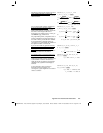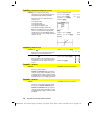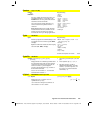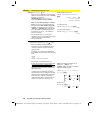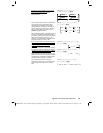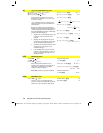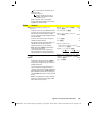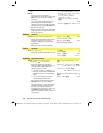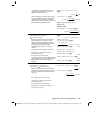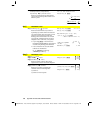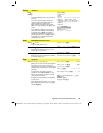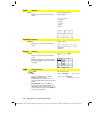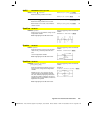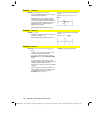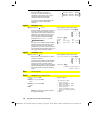
Appendix A: Functions and Instructions 435
8992APPA.DOC TI-89 / TI-92 Plus: Appendix A (US English) Susan Gullord Revised: 02/23/01 1:48 PM Printed: 02/23/01 2:21 PM Page 435 of 132
Apply
solve()
to an implicit solution if you
want to try to convert it to one or more
equivalent explicit solutions.
deSolve(y'=(cos(y))^2
ù
x,x,y)
¸
tan(y)=
x
ñ
2
+@3
When comparing your results with textbook
or manual solutions, be aware that different
methods introduce arbitrary constants at
different points in the calculation, which may
produce different general solutions.
solve(ans(1),y)
¸
y=tan
ê
(
x
ñ
+2
ø
@3
2
)
+@n1
ø
p
Note: To type an @ symbol, press:
TI-89:
¥
§
TI-92 Plus:
2
R
ans(1)|@3=c
ì
1 and @n1=0
¸
y=tan
ê
(
x
ñ
+2
ø
(c
ì
1)
2
)
deSolve(1stOrderOde and initialCondition,
independentVar, dependentVar)
⇒
a particular solution
Returns a particular solution that satisfies
1stOrderOde
and
initialCondition
. This is
usually easier than determining a general
solution, substituting initial values, solving
for the arbitrary constant, and then
substituting that value into the general
solution.
initialCondition
is an equation of the form:
dependentVar
(
initialIndependentValue
) =
initialDependentValue
The
initialIndependentValue
and
initialDependentValue
can be variables such as
x0
and
y0
that have no stored values. Implicit
differentiation can help verify implicit
solutions.
sin(y)=(y
ù
e
^(x)+cos(y))y'
!
ode
¸
sin(y)=(
e
x
ø
y+cos(y))
ø
y'
deSolve(ode and
y(0)=0,x,y)
!
soln
¸
ë
(2
ø
sin(y)+y
ñ
)
2
=
ë
(
e
x
ì
1)
ø
e
ë
x
ø
sin(y)
soln|x=0 and y=0
¸
true
d
(right(eq)
ì
left(eq),x)/
(
d
(left(eq)
ì
right(eq),y))
!
impdif(eq,x,y)
¸
Done
ode|y'=impdif(soln,x,y)
¸
true
DelVar ode,soln
¸
Done
deSolve(2ndOrderOde and initialCondition1 and
initialCondition2, independentVar,
dependentVar)
⇒
a particular solution
Returns a particular solution that satisfies
2ndOrderOde
and has a specified value of the
dependent variable and its first derivative at
one point.
deSolve(y''=y^(
ë
1/2) and
y(0)=0 and y'(0)=0,t,y)
¸
2
ø
y
3/4
3
=t
solve(ans(1),y)
¸
y=
2
2/3
ø
(3
ø
t)
4/3
4
and t‚0
For
initialCondition1
, use the form:
dependentVar
(
initialIndependentValue
) =
initialDependentValue
For
initialCondition2
, use the form:
dependentVar
' (
initialIndependentValue
) =
initial1stDerivativeValue



